Summary
Where there is one problem in business, there are hundreds of solutions from organizational behavior studies. In real business, there is no example that problem does not occur in any organization. To run a business successfully, the company has to face several challenges raised from the perspective of organizational culture, employee’s attitude, superior’s treatment, change in the organization, conflict within individuals or groups.
The study of organizational behavior helps us to overcome these challenges successfully and gives us opportunities to accomplish the desired goal. Furthermore, organizational behavior does not abolish the problem, but it only helps us to reduce them. It is just a way to improve, but not the solution to the problem. This paper is to find out all the problems that occur in the organization and give recommendations to improve.
Introduction
At first, it is needed to introduce myself and also let you know my role. I am ….. and I have visited …… company recently. I have talked with their consultant and found some important information regarding their organizational behavior. I have identified some problems of management and organizational behavior that occur in this organization. My task is to restructure and recognize a major overhaul in this organization. In addition, it is expected to give some recommendations on these problems, identify the opportunities and also show a picture of how the outcomes of these solutions could be evaluated and measured. In order to provide a better understanding, in the beginning, it would be right to present the organizational structure of this company.
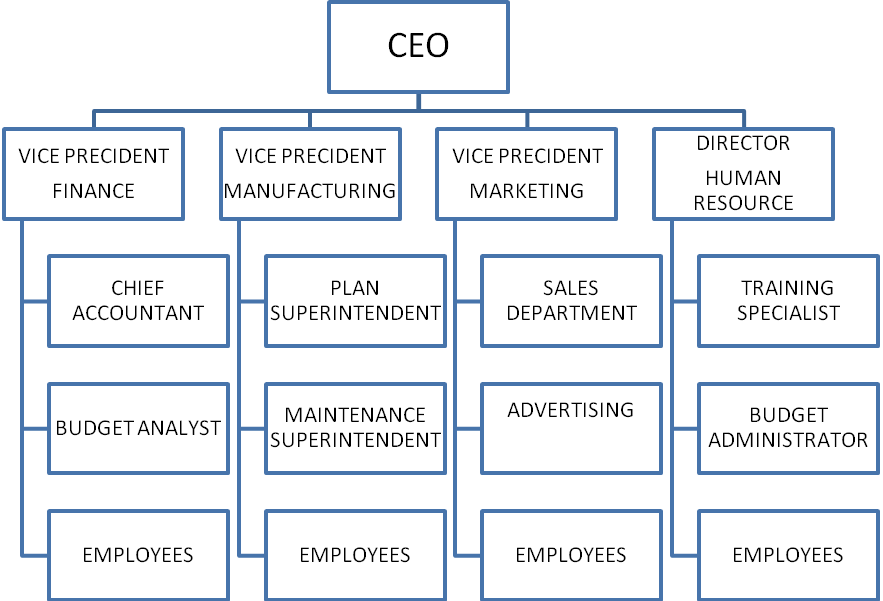
This organization is based on the hierarchy order and it has 330 employees overall. The company is very much committed to retaining its customer relationship. The function of the organization is done through four branches; finance, manufacturing, marketing, and HR departments. Under each department, there are two sections and each section provides the majority of the employees.
Introductory concept
In order to provide a clear idea about the organizational situation, at first, it requires knowing the characteristics of the organizational behavior. The study of organizational behavior helps us to understand the three internal functions of a human being. These are:-
- What people are thinking?
- What do they do?
- What do they feel?
In a similar way, within the organization, the employees feel, think, and do differently and it is the general rule. The objective of Organizational behavior is to convert these different approaches more positively for the company. It is about the people who are at work in every organization and how they can be used to contribute in the most effective ways. The employee-employer relation is to be said as one of the most significant issues of any organization.
It is a crucial factor for the organization to achieve its desire goal in an ethical way. There is no doubt that the employees concentrate more efficiently on their work when they are aware that the employer treats them with higher respect. If we give an example then it would be better to realize how much OB practice is important. We know, relationship marketing is the modern concept of today’s marketing, where the companies create the environment to maintain a long-term relationship with its customer. To do so the cooperation from the employees is must require and it can ensure the increases of profit for the company. Hence, when the trust between the employee and the employer is established, then even if there is no material gain, it provides a sense of self-satisfaction.
Consequently, the employees who are satisfied with their works will get more motivation towards their work and also gain more and more knowledge. It provides a sense of completion and regularity of the employees. In addition, the positive carry-out of organizational behavior leads to an ultimate goal for the organization.
The visiting company is not out of this rule. The evaluation of this company suggests that organizational behavior is the heart of an organization. A questionnaire interview has taken on 67 employees of that organization. It helps to find out where the organization needs to improve, what should have been done, how could be done and so many other relevant issues. The results of evaluating the company’s problems are the field of leadership, motivation, culture, conflict, change, and the like. This paper is to find out the answer to all these answers.
The organizational culture of this company needs to mention. There are different kinds of employees based on race. However, the customer relationship is the focal point of the company. The superiors of this organization always try to give incentives to the subordinates and the employees are motivated by it.
At first, the total system of organizational behavior needs to present. The following diagram is a model of an organizational behavior system.
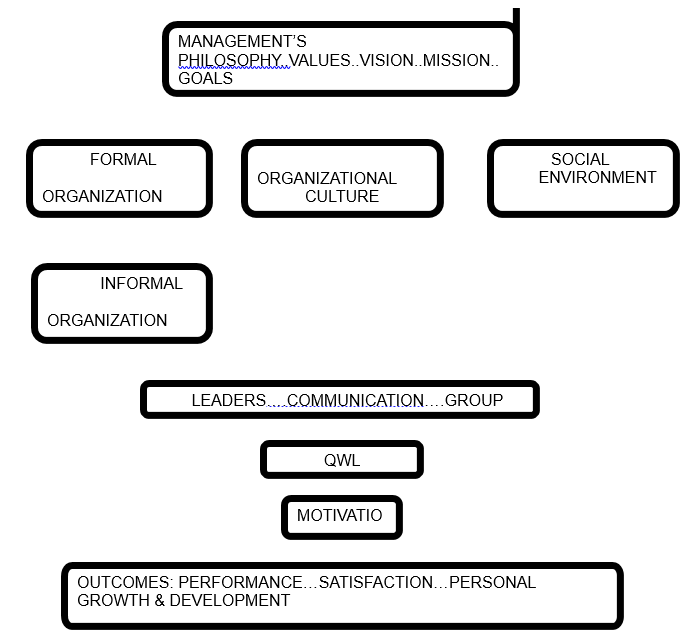
So, therefore it can be said that the total output of an organization depends on the people and their organizational behavior, whether it is positive or negative.
The field of organizational problems
The field of organizational behavior problems represents the different types of troubles whether it is hidden or open, that occurred from the ability, attitude, and learning. There are two types of organizational problems.
- visible organizational problems
- Unseen organizational problems
This paper is to find out how organizational behavior discipline can be applied to the problem in the area of change, structure, culture, motivation, leadership, individuals, groups, conflict, communication, attitude, ability, and learning.
Change
The organization “Mega Look” recently has changed its marketing plan. In 2005, it has become the result of the merger by reaching the agreement to combine two companies; ‘First look’ & ‘Mega collection’. So the change has occurred and that has a larger impact on organizational behavior. So at first, we need to disclose the issue of change regarding organizational behavior.
Change is any modification of any working environment, structure, people, culture, technology and that has an impact on the ways the employees are used to. Change plays a major role in organizational behavior by affecting the total attitude of the employee whether it is welcomed or not.
Importance
The effects of change can be compared to a bucket of water. If one drop of chemical is poured into it, then that would not be considered as water. The same situation happened in case of change in the organization. When a new work or task is assigned then learning new skills is required. In the case of technological change, some people especially those who are not familiar with it. They may fear losing something. From this psychological thought, they resist against it and fear of unknown. Sometimes, they cannot measure whether change is good or not. If we see the example of Arcelor-Mittal then it would not be difficult to get an idea, what was the situation when the two companies combined.
The following diagram shows how people think about any change that occurred in the organization.

Improvement
Change can be originated from inside the organization, but most of the cases it comes from the external environment. Sometimes the passing government rules or laws may not be expected to the company, but they also cannot avoid it. In addition, the new technology or competitors introduce new service and certainly it makes the organization bound to think about the change. It is obvious that the organization generally does not have the intention to change when they goes according to their objectives. But the pressure from the labor unions, customers’ turnover or others who initiate change makes the organization to think about it. The most, obvious and important factor is to implement this change successfully.
“Mary Manusco worked in an office in one of many buildings at a corporate complex that spread over 40 acres. She cheerfully returned from a two-week vacation to find that the whole office of fifty people had disappeared, leaving a bare room. Mary was startled and bewildered; she felt excluded and momentarily was concerned about her job security. …. She later learned that some quick changes had become necessary to prepare her building for new activities. Her office group had been suddenly moved to another building during her absence. Nevertheless, the way the move was handled raised legitimate questions for Mary.
She asked, “Why didn’t they tell me? They knew where I was, so they could have telephoned me. At least they could have written to me so that I would have a letter at home when I returned. Why didn’t a friend call me at home the night before, or why didn’t my supervisor try to contact me? Does anybody care? Is this the way future changes will be handled, too?” (Davis, and Newstrom, 2001).
Solution
As mentioned earlier, there is nothing to do to avoid the unexpected change. The one thing, the management can do to ensure the implementation of change successfully. The followings can be considered significantly:-
- In case of unexpected events the employees need to react properly and quickly.
- The management needs to aware about the problems and the opportunities as well.
- Use of group forces and providing a rationale for change
- Consider the ethical matters that raised by organizational change
- Implementation the proper methods to promote the changes
- Identify and define the weakness and make improvement
Culture
Culture is difficult to define and it is not possible to see, but its physical sign is existed. Culture is to be said as the environment, which surrounds at work and shapes all the activities and performance by its means. Organization culture is the shared meanings that gives a self-identity and distinguish from the others. Stephen P. Robbins defines culture as, “A common perception held by the organization’s members; a system of shared meaning” (Robbins and Judge). As Arcelor-Mittal is a multinational company, it has to employ different types of peoples from different countries, who believe in different culture. So, it is expected that the organizational culture of Arcelor Mittal would be affected from this perspective.
How organization cultures form

Cultural importance
Culture represents the behavior of the people within the organization. It is not usually considered as good or bad. People learn through behaviors either it is rewarded or negative consequences. The behavior repeats when it is rewarded and consequently it become the part of the culture. “Most organizational cultures have historically been implicit rather than explicit” (Davis, and Newstrom, 2001, p.92). Employees learn organizational culture from stories, rituals, material symbols or language.
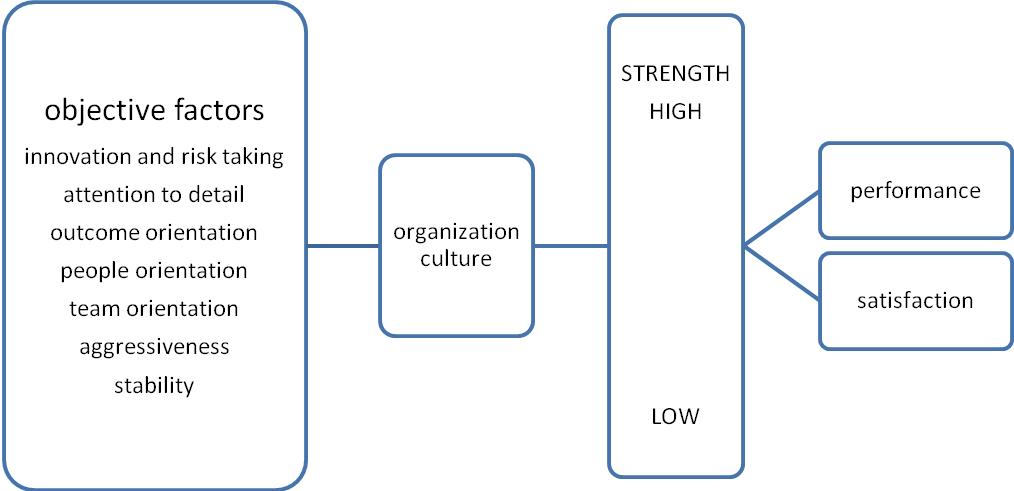
Cultural problems
Organizational culture to a business is to be said as blood to a body. When problem occurs in blood then it affects badly the body and the same is applicable to the business. In real business cultural factors is very important as it plays a major role. It is known that a huge number of peoples from several countries are involved in the activities of Arcelor-Mittal steel industry. So, when new employ appointed, then as he or she unaware about the organizational culture, there is the possibility of cultural behavior problems. There is the possibility of cultural confliction among the employees and it is strongly recommended that management needs to deal with it in proper way. Opportunities: However, if the company can treat with these facts properly, then it is possible to deliver the followings:-
- Productivity: satisfied employees are considered as productive employees. The positive practice of culture encourages the employees to participate more and helps to think them “this is my organization”. It is needless to say then certainly the productivity will be increased.
- Lower cost: from the company’s point of view, hiring and separation is considered as expensive. When the employees are satisfied with the environment of their organization, then the good employees take the responsibility to bring these costs way down. Moreover, positive cultures tend to have fewer employees lawsuits, lower worker’s compensation cost and more satisfied customers.
- Balanced resources: in business money and time are the most valuable resources and these two resources the business never have enough of. So it has to be consumed judiciously. By defining the culture, the company ensures the productive use of these sources (Vinas, n.d.).
Leadership
“Leadership is the process of influencing and supporting others to work enthusiastically toward achieving objectives” (Davis & Newstrom, 2001).
Leadership is an important part of management. The success of the organization depends on strongly the peoples who are in position of leadership. The successful leader can identify which employs are more effective and how they can be used properly. A successful leader has the ability to lead the organization to achieve its desire goal. There is want for good leaders and they are valued by their organization.
Traits of effective leaders
There are some characteristics that belong to a successful leader.
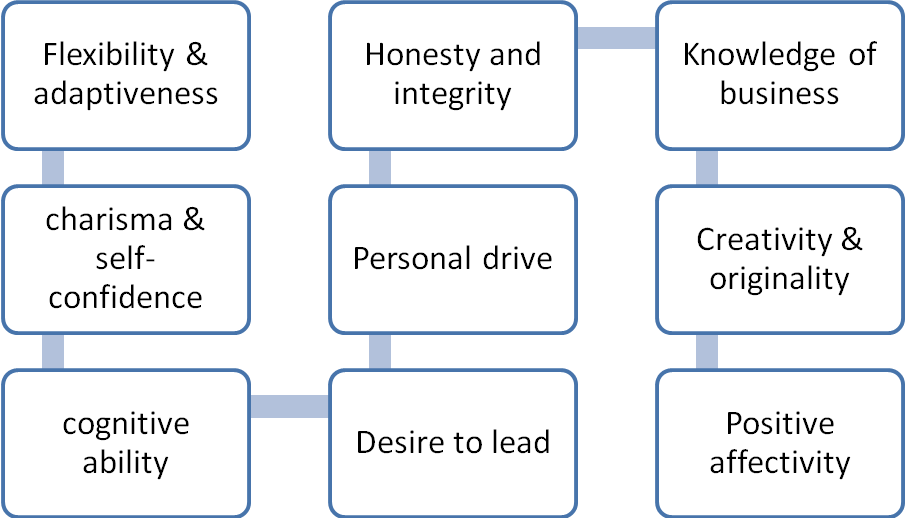
When a leader has these traits then he or she can motivate the employees and by doing this they can ensure the success of the organization. Consequently, the product or service offered by the company can be successful in the marketplace. A successful and efficient leader gives the priority to the employees.
It is because the employees will do the rest because they would think that the company is doing something well for them. In this case to build the loyalty, the company needs to make the employee think that they are cared for. “Recent surveys reveal that pay is not the most important thing in job satisfaction. Personal satisfaction, feeling appreciated, and a feeling of doing something worthwhile all out rank pay as the reason employees stay in their present job”.
Motivation
The concept of motivation is to find out the answer why. Why is more important than how. The motivation can be said in accordance with the Oxford Business Dictionary as, “[t]he mental processes that arouse, sustain, and direct human behavior. It reflects the changes to their physiological and psychological conditions as a result of their previous and current experiences”. Motivation can also be defined as “[f]orces within an individual that account for the level, direction, and persistence of effort expended at work.” (Young, 30 Nov. 2000).
The key elements of motivation are how hard a person tries to reach his destination and how long he tries. Motivation is an internal drive that forces us to move toward the goal we are trying to achieve. The organizational behavior motivates the employees by providing the reason that they have to take action. Motivation is to be said the conscious or subconscious choice inside our mind that makes us to decide whether we will do something or not. The same motivation is not applicable to all.
For example, what motivates you to go the park at the afternoon? Some may go for caring their health or some may go to conduct about their business. We cannot see the motivation but watching the behavior. Why people do something is the result of motivation.
In an organization for the manager, motivation is one of the crucial factors that can influence the employees to do work better. The more they motivate, the more productivity will be increased. In case of small organization, individual motivation is needed. If it is larger organization, then bonus or various types of allowance can be motivation for the employees. Motivation can be classified into internal motivation and external motivation.
Internal motivation is what the people set their goals in internal level. For example, Robin is very excited about the forthcoming announce of promotion of his company. He wants to get the promotion because he is very confident about himself and wants to go further. On the other hand external motivation is what makes us to want to do something. For example, if Robin get the promotion they he will marry his girlfriend.
“It is not an easy task to increase employee motivation because employees respond in different ways to their jobs and their organization’s practices” (Allen, 1998). The superiors need to recognize the individual responses and how they can be motivated. Most importantly, organizational behavior helps to find out these answers.
Conflict
“Conflict occurs when there is natural competition between two or more parties about scarce resources, power and social position” (Participation for Social Harmony (UJYALO) Program, n.d.).
Conflict occurs, when:-
- Disagreement: when disagreement occurred regarding any issue then there is the possibility of conflict.
- Emotional antagonisms: sometimes from the emotional antagonisms or extreme friendliness or hate causes the conflict.
- Interpersonal difficulties: in real life usually some difficulties exist in interpersonal level. These difficulties are the reason for conflict.
- Anger: anger is the strong reason for the conflict. It makes the people most of the time to make wrong behavior.
- Mistrust: mistrust may also lead to unexpected conflict. The more complexity in the organization, the more mistrust occurred.
- Friction between individuals or groups: the friction between the individuals or groups certainly makes the situation complex and it causes the conflict.
Effects of conflict
Conflict arises within an employee, between groups or individuals. In real business it is a common issue and unsurprisingly it draws an imperative attention from the OB point of view. It largely affects the normal direction of the company which is obvious. The negative effects of conflict are briefed below:-
Negative effects of conflict
- Misallocation of resources: because of the conflict, the risk of misallocation of resources becomes high. It provides tension and from tension it is certain that the proper allocation of resources is quite impossible.
- Barriers to communication: communication is an important part of organizational behavior and it has a significant role in effective activities. But the conflict can become the barriers to communication and hamper the total function of the organization.
- Lowers productivity: as it has said conflict causes the misallocation of resources and is a barrier to communication, then it is obvious that it lowers the productivity.
- Stressful: it is needless to say that conflict causes the stressful situation in the organization. Consequently, the stressful situation interrupts the normal activities of the organization.
- Creates “us versus them”: conflict creates the group and the groups are formed on the basis of “us versus them”, which is very harmful for the organization.
- Produces irresponsible behavior: the motivation of the employee decreases when the conflict rises. The reduction of motivation produces irresponsible behavior.
Conflict is not all bad; it has positive effects also. It would not be wrong to say that the positive outcome of conflict is more than the negative. The positive outcomes of conflict are shortly briefed below:
Positive effects of conflict
- Leads to new ideas: Generally conflict occurs from the complex situation. The absence of solution is the reason of conflict. So after the conflict the necessity of solution becomes headache and new ideas evolved.
- Renewal in relationship: sometimes the mistrust causes the bad relationship within individuals or group. But when the two parties become conflicted, then there is the possibility for renewal relationship.
- Promotes organizational vitality: vitality to the organization can be compared with the diesel to machine. To run the organization successfully, it requires the strength and conflict promotes this vitality.
- Helps individuals and groups establish identities
- Increase productivity
Resolution strategy
Generally the conflict provides two types of outcomes; the actual winning or losing. But actually there are at least four strategies and each of these represents the different degree.
Avoiding: This is the most negative outcome from the conflict. This approach provides the low concern of both parties and the result is lose-lose.
Smoothing: This strategy is the result of accommodating the other party’s interest. This can be termed as lose-win outcome.
Forcing: In this strategy the tactics is used to force the other party to achieve win. It is considered as aggressiveness strategy. The outcome of this strategy is win-lose.
Confronting: This is to be said as the best strategy that provides the best result. The function of this strategy is to face the conflict and make a solution and resulting in a win-win outcome.
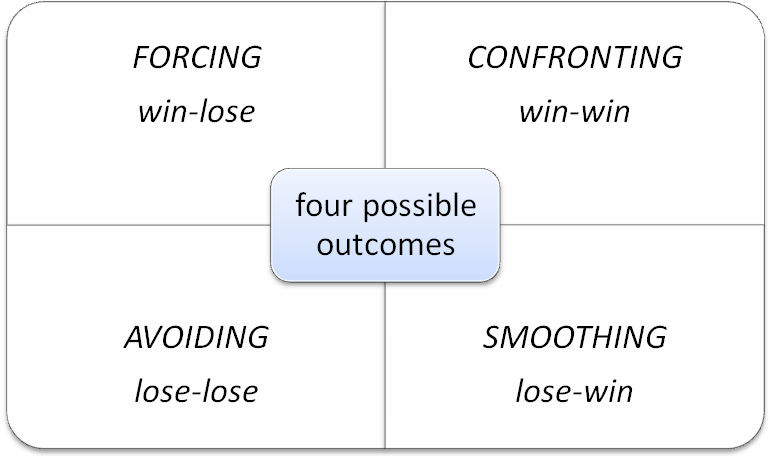
So it is strongly recommended that when there is the possibility of conflict or even conflict occurs, then confronting would be the best strategy to face the conflict. It can ensure the better solution and maximize the achievement for both party’s objective. In addition, the other strategies represent different possible intentions and the situation demands which strategy will be applicable. Not the confronting strategy does provide better result all the time. The following story can help us to understand how to deal with in this situation.
“Karla, the supervisor of a small office staff, had a problem. Her secretary, Maureen, had become increasingly careless about her morning arrival time. Not only did Maureen almost never arrive before 8 A.M. But her tardiness varied from a few minutes to nearly a half hour. Although Karla was reluctant to confront Maureen, she knew she must do so or the rest of the staff would be unhappy.
Karla called Maureen into her office soon after Maureen arrived the next morning and drew upon her assertiveness training. “You have been arriving late almost every day for the past two weeks,” she began. “This is unacceptable in an office that prides itself on prompt customer service beginning at 8 a.m. I recognize that there may be legitimate reasons for tardiness on occasion, but I want you to get to work on time most days in the future. If you don’t, I will insert a letter into your personnel file and also note your behavior on your six-month performance appraisal. Will you agree to change?” (Davis, and Newstrom, 2001).
Job satisfaction, performance, ability, attitude, learning
It is interesting to know why people are attached to their job. Why they stay in their sector. Some experts argue that job satisfaction creates the opportunity to provide better performance. On the other hand the other party says that when the employees provide better performance, then they feel satisfaction in their job. The job characteristics model shows the relation between the job satisfaction and performance. It needs to mention that performance is the result of ability and job satisfaction is the result of the combination of attitude and learning. To provide better performance motivation is certainly needed.

Motivating potential score
Motivating Potential Score =Skill Vareity + Task Identity + Task Signivicance/3 ×AUTONOMY×FEEDBACK
A questionnaire interview
After evaluating the organizational field, a questionnaire interview was taken which represents the total criteria of the organization. The questions were easy and simple language was used.
- Hello, my name is ………………………………………………………………..
- How long you have been with this company?………………………………………………………………..
- Why did you choose this organization?………………………………………………………………..
- What are some of things you prefer of this organization?………………………………………………………………..
- What are some of things you dislike of this organization?………………………………………………………………..
- Is the organizational culture appreciated or not? Why and why not?………………………………………………………………..
- Are you satisfied with your superiors?………………………………………………………………..
- If you were given the chance to modify something, what is one thing you would change of this organization?………………………………………………………………..
- What do you think the organization needs to do to implement your suggestion?………………………………………………………………
- What’s your expectation from this organization in future?………………………………………………………………
Evaluation/The outcomes of the questionnaire interviews
From the questionnaire section, it has found that most of the employees are not satisfied with their superiors and also about the internal culture. When the organization became in new form, half of the employees were stressful about the change.
Recommendations
There is the debate between the management and the organizational behavior. The practice of positive organizational behavior cannot solve the problems of the organization. It only can reduce the complexity within the organization. If the proper implementation of the above discussion is ensured, then it can say that at least the flexibility in the organization will be increased. Furthermore, it is strongly recommended that the management needs to ensure a democratic environment to increase the productivity. To do so the organizational culture should be appropriate for all, the employee needs to be motivated properly.
Conclusion
So, from the above discussion we can say that organizational behavior is an important issue in real business life. “Organizational behavior is about people at work in all kinds of organizations and how they may be motivated to work together in more effective ways” (McShane, 2003). The success of the organization mainly depends on the proper implementation of positive organizational behavior. The problem cannot be the reason to interrupt the normal activities of organization. Organizational behavior helps us to understand how the employees can be more effective and how more output can be produced.
References
Allen, Gemmy. (1998). Management Modern. Web.
Davis, Keith., and Newstrom, W John. (2001). Organizational Behavior. 11th edition, Tata McGraw-Hill, ISBN-0-07-047264-5).
Hackman, R. J., and Oldham, R. G., (1980). Work Design. Addison-Wesley Publishing Co. Web.
McShane-Von Glinow (2003). Organizational Behavior, Second Edition [University of Phoenix Custom Edition e-text]. The McGraw-Hill Company.
Participation for Social Harmony (UJYALO) Program. (n.d.). Conflict and its Effects. Web.
Robbins P. Stephen., and Judge, A. Tim. Organizational Behavior 12 edition. Prentice Hall.
Vinas, Tonya. (n.d.). How to create an atmosphere that supports your business goals. business. Web.
Young, C. Brian. (2000). Methods of Motivation: Yesterday and Today.